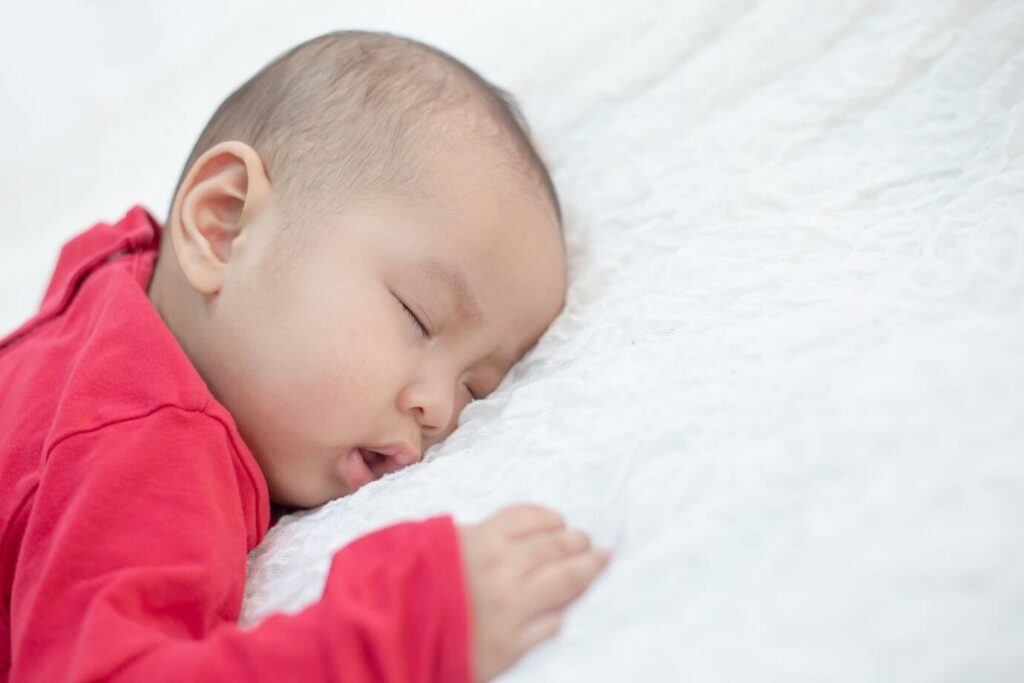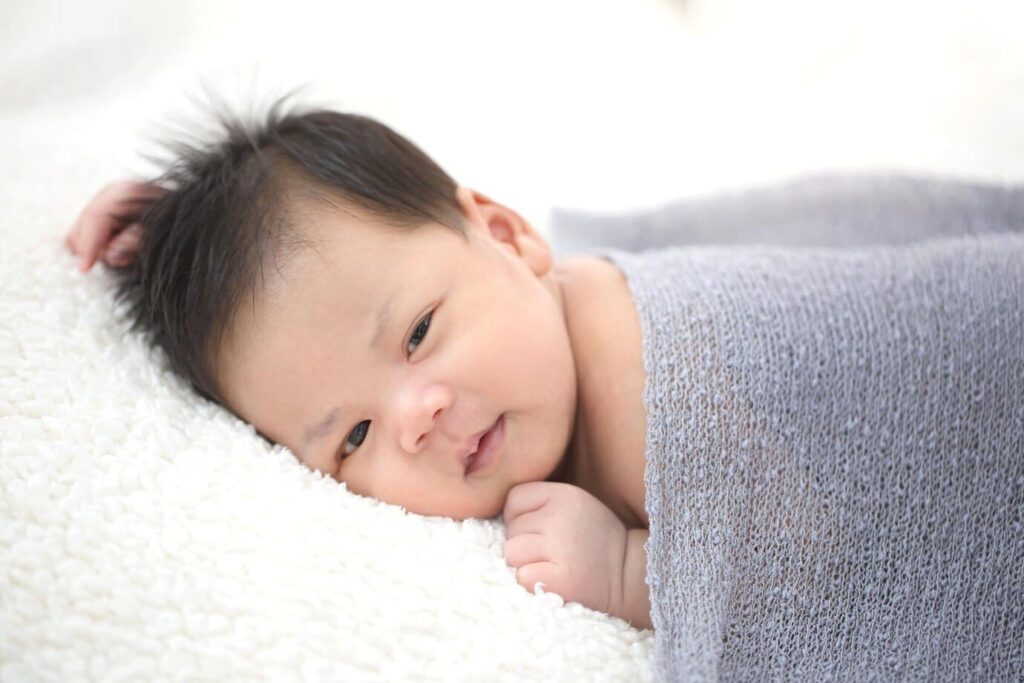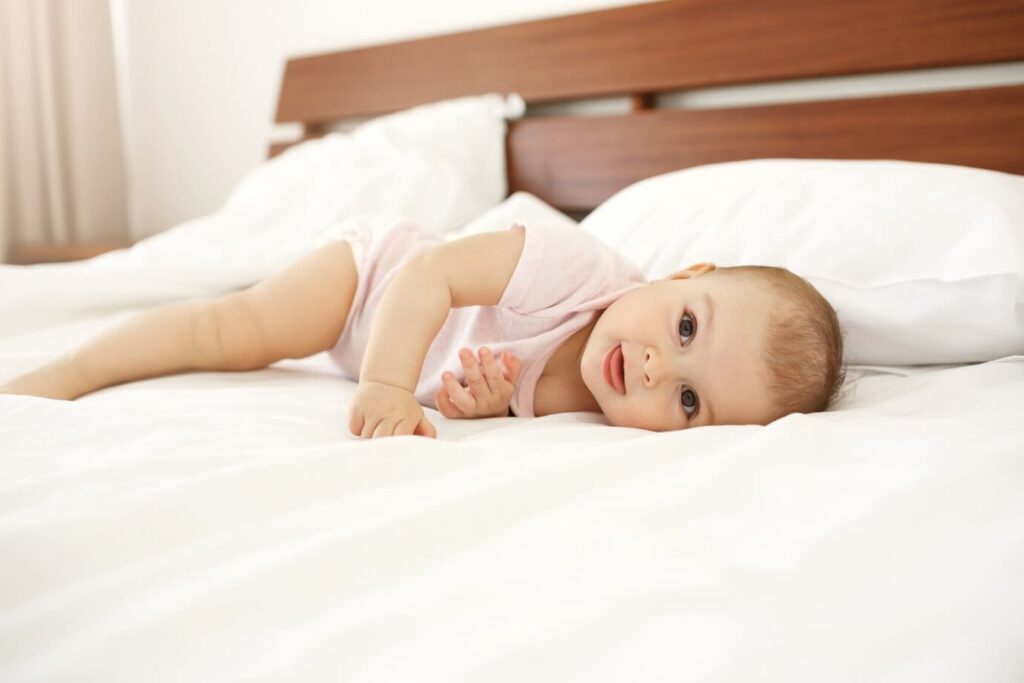As a new parent, I understood the importance of a good night’s sleep, but I didn’t realize all the specifics about creating a safe sleep environment for my baby. When I walked into the nursery one night to find my baby sleeping face down in mattress with her face pressed into the mattress, it set off alarm bells and sent me scrambling to do research.
What I found shocked me – babies sleeping face down in a mattress comes with a host of hazards, including a significantly increased risk for SIDS (Sudden Infant Death Syndrome). I never wanted to chance anything happening to my little one, so I knew I had to take all measures to prevent face down sleeping in her mattress.
After learning all about the risks, surrounding my baby with safe, vetted products, and practicing the best sleeping habits to prevent her from sleeping face down in her crib mattress, I now have peace of mind around her sleep. Every parent deserves that same confidence and education on why face down isn’t the way to go.
If your baby is sleeping face down in their mattress or you’re unsure what precautions to take, use this comprehensive guide covering all the essentials around face down snoozing hazards and prevention methods. With a few tweaks to your routine, you’ll rest easy too. Keep reading and breathe a little easier tonight!
Understanding the Dangers of Face Down Sleeping
Babies sleeping face down comes with a host of alarming health risks that all parents should know about. The main concerns include:
Suffocation and Blocked Breathing
With their face pressed into the mattress, infants can suffer restricted airflow and difficulty breathing. Soft bedding is an additional hazard as it contours to the nose and mouth. Tragically, this leads to some infants suffocating in their sleep when face down.
I remember reading one heartbreaking account from a grieving parent who lost their baby this way. It reinforced how real – and preventable – this danger can be by ensuring back sleeping instead.

Increased SIDS Risk
The link between tummy sleeping and Sudden Infant Death Syndrome has been studied extensively. Research shows stomach sleeping increases an infant’s risk of SIDS over 2 times compared to back sleeping.
This holds true at all infant ages until 1 year old. Some theories on why face down sleeping negatively impacts breathing control and arousal mechanisms include:
- Carbon dioxide build-up: When face down, babies rebreathe exhaled carbon dioxide trapped near the mattress instead of getting fresh air. This can lead to oxygen deprivation.
- Development issues: Prone positioning early on negatively affects development of upper body strength, motor skills, arousal capability, and more – all protective factors against SIDS.
As a parent, understanding all the components of safe infant sleep guidelines took on a whole new urgency after reading about SIDS risk. I immediately stopped letting my newborn nap tummy down on me.
When it comes to face down sleeping, the repeated advice rings true: back is best!
Developmental Problems
Extended face down pressure on one part of an infant’s head can also create flattened areas. This requires correction with helmet therapy in severe cases.
Our pediatrician warned us that the soft, malleable bones of our baby’s skull needed ample time rounding out all areas in these early months. Sleeping face down limits that healthy growth.
While less dangerous than suffocation, the resulting head asymmetry and need for corrective intervention was concerning enough for us to reinforce back sleeping only.
After learning about all these alarming risks, I couldn’t fathom allowing my baby’s sweet face to nuzzle into the mattress ever again. The fear of losing her catalyzed me into creating an ultra-safe sleep space and sticking to best practices that prevented any tummy time temptation during slumber from day one.
Alternative Sleep Positions
With face down sleeping clearly off the table, what sleep positions can safely cradle your little one instead?
Back Sleeping Recommended Up To 1 Year
The American Academy of Pediatrics advises that babies sleep exclusively on their back until age 1. After a year, continuing back sleeping remains the safest option according to SIDS prevention research.
I committed to consistent back positioning right away for my baby. I even gently roll her back anytime she repositions herself onto her side in the night. Knowing I won’t find her snoozing tummy-down brings me comfort.
Of course, exceptions exist for babies with certain health conditions, like reflux or breathing issues. That leads us to our next section…
When Tummy Sleeping May Occur
For infants with special medical circumstances like severe reflux or respiratory conditions, prone sleeping may be necessary and recommended by your pediatrician. These situations do require extra vigilance and monitoring measures.
The important distinction remains that tummy positioning should only happen under medical guidance based on your baby’s needs – not by accident or ease of getting them to sleep. Any steps we can take to allow back sleeping are best.
Okay, so we now know back sleeping is the way to go. Next let’s look at…

Creating a Safe Sleep Environment
Setting up an ultra-safe space for your back-sleeping baby takes some intentional adjustments. Here are my top tips:
Firm Surfaces
Mattresses should be firm with tight-fitting sheets to prevent gaps between bedding. No memory foam, pillow tops, or cushy mattresses. Waterproof the crib mattress if needed as well.
No Loose Bedding
Keep blankets, stuffed animals, crib bumpers, and extra pillows out of baby’s sleep space. Use a wearable blanket or sleep sack instead of loose covers.
Sleep Positioners Are Unsafe
Do not use wedges, body positioners, or nests due to suffocation hazards. These can trap babies face-down. Sleep sacks keep your little one snug on their back all night instead.
By focusing on these basics, I felt confident my baby had the right setup for safe, face-up slumber. Combine that with consistent sleeping practices, and you’ve got yourself a winning nighttime formula!
Now what questions might still be crossing your mind about your little one’s face-planting tendencies? Let’s explore some common concerns parents have.
| Do | Don’t |
|---|---|
| Place baby on back to sleep | Allow stomach sleeping |
| Use a firm, flat mattress | Use soft bedding or pillows |
| Keep crib free of loose bedding | Use crib bumpers or positioners |
| Use a wearable blanket | Cover head or allow face to be obscured |
| Follow medical guidance if prone sleep needed | Attempt to re-position baby once they can roll |
Common Questions and Concerns
Wondering whether you should worry about your tummy snoozing baby? Concerned your infant will resist back sleeping attempts? Here are some reassuring answers.
Transitioning From Tummy Sleeping
If your baby is used to dozing face down, it may take some perseverance transitioning to back only. But stick with it through fussiness! Expect 2-3 tough nights.
Then continue reinforcing it during all sleep instances – daytime naps too. Over time it will stick. Hang in there and remember it’s for their wellbeing.
What If They Roll Onto Their Stomach?
Once babies reach rolling age, they may flip themselves over in their sleep. While disconcerting, parents can take comfort in knowing risk greatly reduces once infants gain this mobility skill.
I still always return my baby to back sleeping after checking on her if she has done a middle-of-the-night roll. As the saying goes: back to sleep, belly to play!
For additional concerns about preventing SIDS, encouraging healthy development, products to assist with back sleeping, and much more, keep reading below.
Now let’s move onto proactive steps for stopping face down sleeping before it ever starts.

Preventing Face Down Sleeping
An ounce of prevention is worth a pound of cure when it comes to reinforcing back sleeping over risky tummy positioning. Here is how to curb the habit from day one:
Encourage Back Sleeping During All Naptimes
Get babies used to back snoozing during daylight naps from the early newborn stage. This prevents preference for tummy dozing later on.
Explain the importance of back sleeping to caregivers like grandparents so they follow safe positioning during babysitting as well.
Supervise Tummy Time Awake Only
Let baby build those neck and upper body muscles during supervised play – not overnight sleep! I allow tummy time only when I’m able to monitor baby fully awake.
Once she starts dozing off, I gently roll her onto her back in the crib again. Consistency is key.
Respond at First Signs of Face-Down Attempts
At my baby’s 2 month appointment, the pediatrician said babies may start intuitively “pushing” their face forcefully down. React right away by rolling them back if this occurs.
Catching that early signal reinforces healthy back sleeping before dangerous tummy preference becomes habit.
With prevention starting early and consistency in every sleep session, I can rest easy knowing my baby’s slumber is as safe as possible. Sweet dreams!
Now what warning signs should have you contacting your pediatrician about face down sleeping concerns?
Monitoring for Warning Signs
While prevention works wonders, babies keep parents on their toes. Sometimes situations may warrant a call to the doctor involving sleep struggles like:
- Baby frequently ends up face down regardless of back positioning
- Sleeps soundly only while prone
- Experiences scary pauses in breathing
- Skin color changes to pale, blue, or cyanotic during sleep
- Shows signs of respiratory distress
Documenting episodes, capturing videos of odd occurrences, and pointing out patterns helps your pediatrician best evaluate if any underlying issues make prone sleeping hard to avoid or monitor appropriately for safety.
Some conditions like laryngomalacia or severe GERD may require alternate sleep guidance. Working as a team with your doctor ensures you cover every base supporting healthy sleep.
Developing Safe Sleep Habits
Starting healthy sleep habits early lays a strong foundation for your baby’s slumber through infancy and beyond. Following safe sleep best practices takes diligence but gives great peace of mind.
Ideal Timing for Sleep Training
Experts recommend beginning sleep training around 4-6 months once feeding is well established. This prevents accidental starvation from restricting night feeds too early. By 4 months, babies also develop deeper sleep cycles making training more effective.
Techniques like Swaddling, White Noise and Bedtime Routines
Swaddling provides a snug feeling but stops once baby shows signs of rolling over. White noise masks disruptive household sounds. A predictable bedtime routine signals sleepy time. All encourage restful sleep.
Promoting Self-Soothing
Sleep training techniques aim to help babies learn to self-soothe to sleep. This may involve some crying at first, but prevents sleep crutches down the road. Using pacifiers facilitates self-settling.
Handling Sleep Regressions
Developmental milestones like growth spurts or teething often disrupt sleep. Regressions pass within a few weeks with consistent sleep training. Stay the course for long-term success.
Nailing Daytime Naps
Quality daytime snoozing directly impacts nighttime sleep. Aim for a morning and afternoon nap, watch for tired signs like eye rubbing, and put baby down drowsy but awake. Consistency training helps tremendously.
Crib Safety Checklist
Preparing a hazard-free crib takes vigilance, but gives you reassurance during the many hours baby will spend sleeping there. Use this checklist to identify and correct any risks in your baby’s sleep sanctuary.
Crib Setup and Mattress Firmness
Your crib should have no more than 2 3/8 inches between slats to prevent entrapment. The mattress should fit snug with only two fingers width between edge and crib. Choose a firm surface without indentations.
Eliminating Blankets, Pillow and Stuffed Animals
To reduce suffocation risks, never put pillows, stuffed animals, loose blankets or crib bumpers in the sleep area. Use wearable blankets and sleep sacks instead.
Appropriate Sleep Clothing and Swaddle Transition
Dress baby in fitted, thin cotton clothing without dangerous ties or hoods. Stop swaddling as soon as signs of rolling over appear and switch to sleeved sleep sacks.
Room Temperature and Lighting
Maintain bedroom temperature at around 68-72°F. Install dimmers to keep lighting low for sleep cues. Blackout curtains also signal restful times.
Crib Age Milestones and Transition Timing
Adhere to manufacturer guidelines on crib weight limits and transition timing. Convert to toddler bed around age 2 or when baby is able to climb out unaided to avoid injuries.
Dangers of Co-Sleeping
Co-sleeping, which involves baby sharing a sleep surface with parents or siblings, can seem convenient but poses serious risks. Even the most well-intentioned parent can end up in an unsafe sleep situation when overly tired. Understanding co-sleeping hazards enables making informed choices to protect your baby.
Suffocation and Entrapment Risks
Babies lack mobility and the strength to reposition their head if it ends up tucked against a pillow or covered by blankets when co-sleeping. Loose bedding can contribute to accidental smothering.
Even your own arm draped across your baby’s body can cause enough airway obstruction to lead to tragedy in the middle of the night. Tragically, many infant deaths have occurred when babies became trapped between the mattress and wall or headboard.
Startling Awake and Rolling Over Risks
Babies naturally startle, thrash arms and legs, and make sudden movements which increase the chance of rolling into hazardous areas when co-sleeping. If asleep parents roll onto the baby, the results can be fatal due to the size difference.
Links to Increased SIDS Rates
Research shows co-sleeping triples the risk of sudden infant death syndrome (SIDS). Reasons may include overheating from shared body heat, carbon dioxide buildup in soft bedding, or disturbances in protective reflexes.
When Co-Sleeping May Work
If your pediatrician approves co-sleeping due to a medical need or you strongly prefer it, take safety precautions. Never sleep with baby on couches or chairs which are extremely dangerous. Place baby between mother and wall with no blankets or pillows around.
While co-sleeping closeness appeals to many parents, understanding the risks enabled me to make an informed choice to use a bedside bassinet and crib instead. I chose not to chance my baby’s safety. Know the facts so you can make the right decision for your family too.
Conclusion
While adorably snuggly, allowing babies to sleep face down in their mattress actually puts them at great risk for suffocation, Sudden Infant Death Syndrome (SIDS), and other alarming dangers. Pediatricians strongly advise exclusive back sleeping until 1 year old along with creating a safe sleep environment to prevent rollovers.
Following safe sleep guidelines, reinforcing back snoozing consistency early on, and supervising awake tummy time sets healthy habits in motion from the start. Monitoring babies closely means spotting warning signs promptly for medical evaluation too.
With education on risks and proactive prevention measures, parents obtain valuable tools for reducing hazards. No parent wants to chance losing a child due to accidental sleeping conditions.
Hopefully this guide brought parents everywhere one step closer to couching their little one’s slumber with total confidence and peace of mind. Sweet dreams!
FAQ – Baby sleeping face down in mattress
Why is it dangerous for babies to sleep face down in the mattress?
Sleeping face down increases the risk of suffocation as a baby’s nose and mouth can press into the mattress blocking their airway. Prone sleeping also traps carbon dioxide around baby’s face and contributes to overheating, both linked to higher SIDS risk.
At what age can babies start sleeping on their stomachs?
Medical guidelines recommend back sleeping until 1 year old to reduce SIDS risks. Once a baby is rolling front-to-back on their own you can allow them to find their preferred sleep position, but always place them onto their backs initially.
My baby flips onto their stomach in the crib – should I worry?
Once babies reach 4-6 months and have sufficient muscle strength and coordination to roll front-to-back easily, the risk reduces if they maneuver onto their stomach in sleep. But parents should continue initially positioning babies onto their backs until 1 year old per safety recommendations.
What kind of crib mattress is safest to prevent face down risks?
Choose a firm crib mattress covered only in fitted sheets to eliminate suffocation hazards. Avoid pillow tops, cushy padding, or memory foam which could conform to the nose/mouth if face down. Breathable mesh mattresses can help dissipate carbon dioxide as well.
How can swaddling impact tummy sleeping risks?
While helpful preventing startles, traditional swaddles do restrain movement. Parents should stop swaddling as soon as babies show signs of attempting to roll over. Use an arms-free sleep sack instead if still needing security but with room to reposition sides/back if face down.












